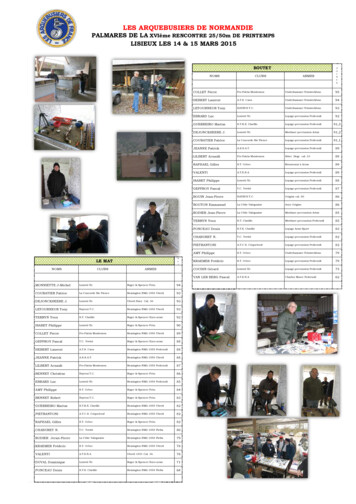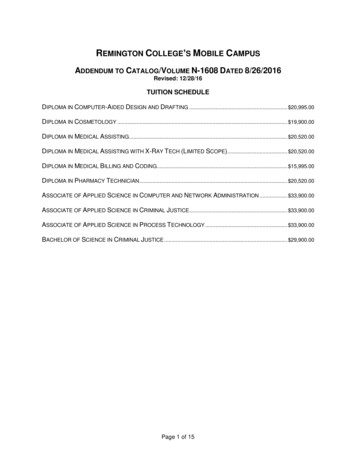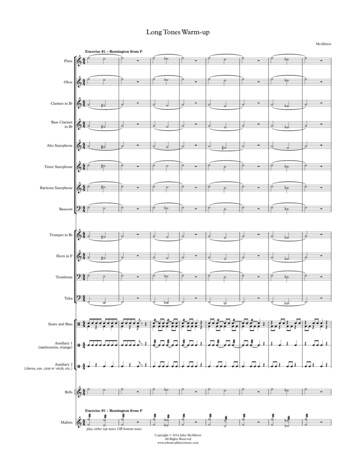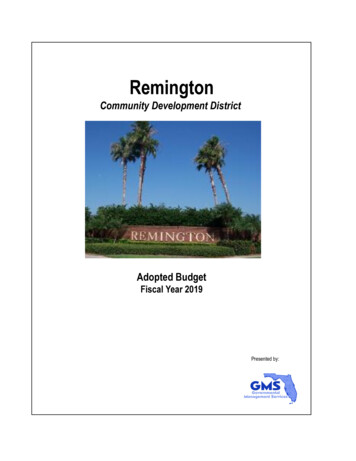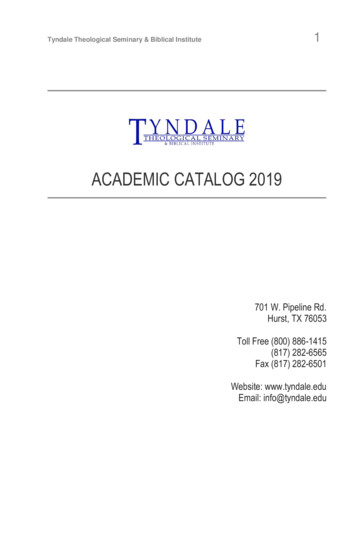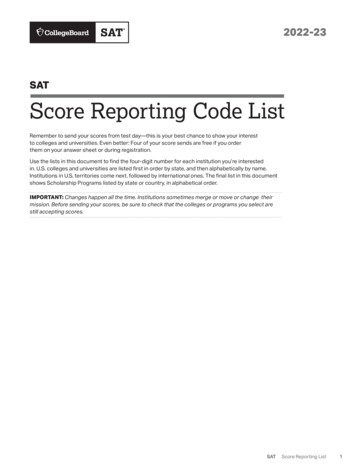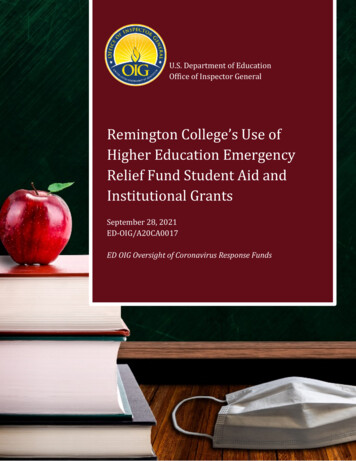
Transcription
U.S. Department of EducationOffice of Inspector GeneralRemington College’s Use ofHigher Education EmergencyRelief Fund Student Aid andInstitutional GrantsSeptember 28, 2021ED-OIG/A20CA0017ED OIG Oversight of Coronavirus Response Funds
NOTICEStatements that managerial practices need improvements, as well as other conclusionsand recommendations in this report, represent the opinions of the Office of InspectorGeneral. The appropriate Department of Education officials will determine whatcorrective actions should be taken.In accordance with Freedom of Information Act (Title 5, United States Code,Section 552), reports that the Office of Inspector General issues are available tomembers of the press and general public to the extent information they contain is notsubject to exemptions in the Act.
UNITED STATES DEPARTMENT OF EDUCATIONOFFICE OF INSPECTOR GENERALAudit ServicesSeptember 28, 2021Pam BellPresidentRemington College7131 Business Park LaneLake Mary, FL 32746Dear President Bell:Enclosed is our final audit report, “Remington College’s Use of Higher Education Emergency Relief FundStudent Aid and Institutional Grants,” Control Number ED-OIG/A20CA0017. This report incorporates thecomments you provided in response to the draft report. If you have any additional comments orinformation that you believe may have a bearing on the resolution of this audit, you should send themdirectly to the following Department of Education official, who will consider them before taking finalDepartmental action on this audit:Dr. Michelle Asha CooperActing Assistant SecretaryOffice of Postsecondary Education400 Maryland Avenue, S.W.Washington, DC 20202The U.S. Department of Education’s policy is to expedite audit resolution by timely acting on findingsand recommendations. Therefore, if you have additional comments, we would appreciate receivingthem within 30 days.Sincerely,/s/Daniel P. SchultzDirector of Pandemic Relief AuditsEnclosure400 MARYLAND AVENUE, S.W., WASHINGTON, DC 20202-1510Promoting the efficiency, effectiveness, and integrity of the Department’s programs and operations.
Table of ContentsResults in Brief . 1Introduction . 6Finding 1. Remington College Generally Used Student Aid Funds for Allowable andIntended Purposes . 10Finding 2. Remington College Did Not Always Use Institutional Grant Funds for Allowableand Intended Purposes or Comply with Federal Procurement Requirements . 13Finding 3. Remington College Did Not Follow Federal Cash Management Requirements. 25Appendix A. Scope and Methodology. 32Appendix B. Acronyms and Abbreviations. 39Remington College Comments . 40
Results in BriefWhat We DidThe objective of our audit was to determine if Remington College used the Student Aid(Assistance Listing Number (ALN) 84.425E) and Institutional (ALN 84.425F) portions of itsHigher Education Emergency Relief Fund (HEERF) grant funds for allowable and intendedpurposes. Our audit covered Remington College’s use of HEERF 1 funds from the grantaward date 2 through September 30, 2020. Because Remington College drew down butdid not expend all Institutional grant funds by September 30, 2020, we also included inour review expenditures through December 31, 2020, that were paid for withInstitutional grant funds that the school had drawn down by September 30, 2020. Ouraudit also covered Remington College’s cash management practices and reporting ofHEERF expenditures.To achieve our audit objective, we interviewed Remington College officials responsiblefor drawing down, managing, awarding, spending, and reporting on the school’s HEERFgrant funds. We also reviewed Remington College’s policies and procedures and otherdocumentation (for example, bank statements, invoices, student records) for managing,authorizing, and accounting for HEERF-related transactions and expenditures.Additionally, we reviewed a sample of Student Aid grant distributions and Institutionalgrant expenditures to determine whether Remington College used the Student Aid andInstitutional portions of its HEERF funds for allowable and intended purposes. We alsocompared the timing and amounts of drawdowns of HEERF funds with accountingrecords (expenditure information) to determine whether Remington College minimizedthe time between drawdown and disbursement of the funds. Lastly, we reviewed HEERFreports that Remington College posted on its website covering expenditures from thegrant award date through September 30, 2020, for the Student Aid portion and throughDecember 31, 2020, for the Institutional portion. We reviewed the HEERF reports andRemington College’s accounting records to determine whether the school reportedtimely and quality information.In this report, “HEERF” generally refers to both the Student Aid and Institutional grant funds. We use“Student Aid” and “Institutional” when the information is specific to the respective grant.1The award date for Remington College’s Student Aid grant was April 25, 2020, and the award date forits Institutional grant was May 5, 2020.2U.S. Department of EducationOffice of Inspector GeneralED-OIG/A20CA00171
What We FoundRemington College generally used the Student Aid portion of its HEERF grant funds forallowable and intended purposes but did not always use the Institutional portion of itsfunds in accordance with Federal requirements. We found that Remington College spentInstitutional funds for several unallowable purposes and did not always follow Federalprocurement and cash management requirements. Specifically, Remington College improperly used 80,121 of Institutional grant funds to purchase multiyearsoftware subscriptions that extend beyond the supplemental grant period; may have improperly used 64,985 of Institutional grant funds to cover costsassociated with its purchase of student computers; 3 did not always use a competitive procurement process for Institutional grantpurchases over 10,000, contrary to Federal regulations; and did not minimize the time between drawing down and spending its Institutionalfunds nor deposit excess HEERF funds (Student Aid and Institutional) in aninterest-bearing account, contrary to Federal regulations.We also determined that the information in Remington College’s required HEERFreports posted on its website was generally accurate, complete, and timely.What We RecommendWe recommend that the Assistant Secretary for Postsecondary Education— Require Remington College to return to the U.S. Department of Education(Department) the 80,121 in Institutional grant funds spent beyond thesupplemental Institutional grant period or reallocate the funds to otherallowable costs. Clarify whether the costs that Remington College initially charged to itsInstitutional grant for student computers were allowable under the law andexisting guidance, and determine whether Remington College’s subsequentAs discussed in Finding 2, Department guidance regarding the use of Institutional grant funds underHEERF suggests that if a school experienced “disruption of instruction” as a result of the coronavirus, theschool could charge the costs of computers purchased under existing practices to its HEERF grant. Thisguidance appears to reflect a broader interpretation of allowable costs under the relevant part of thestatute.3U.S. Department of EducationOffice of Inspector GeneralED-OIG/A20CA00172
reallocation of costs for other expenses in the amount of 64,985(corrective actions) was appropriate. Determine whether the 639,400 that Remington College charged to itsInstitutional grant for contracts awarded without a competitiveprocurement process was reasonable when compared to the quality andcosts of suitable alternatives, and if not, require appropriate correctiveactions. Require Remington College to ensure that school officials responsible formaking purchasing decisions receive sufficient training on Federal rules andregulations related to grant administration and management. Require Remington College to incorporate Federal requirements related togrant performance periods (allowable costs), procurements, and cashmanagement in its policies and procedures for managing HEERF grant funds. Determine whether Remington College accurately calculated interest andensure that the correct amount of interest is returned to the Federalgovernment in accordance with 2 Code of Federal Regulations (C.F.R.)§ 200.305(b)(9).Remington College CommentsWe provided a draft of this report to Remington College for comment. We summarizeRemington College’s comments at the end of each finding and provide the full text ofthe comments at the end of this report (see Remington College Comments).Remington College stated that it agreed with Finding 1.Remington College disagreed with Finding 2 and Recommendation 2.1, but it did notexplicitly agree or disagree with Recommendations 2.2–2.5. Remington Collegedisagreed with sub-finding, Subscriptions Extending Beyond Supplemental GrantPerformance Period, stating that the software was for the direct benefit of students andsupported the school’s transition in educational programming in response to thecoronavirus. Remington College disagreed with sub-finding, Student ComputerPurchases, stating that the increased cost of student laptops was attributable to asignificant change in the school’s delivery of instruction. Remington College disagreedwith sub-finding, Competitive Procurement Processes, stating that it was best forstudents to have a seamless transition without months of delay from vetting, testing,and negotiating with other vendors. Remington College acknowledged that it did solicitbids and proposals before executing some contracts but noted that in some cases, noresponses were received from prospective vendors, and in other cases, the solutionoptions were so limited that comparable bids were unavailable. While it disagreed withU.S. Department of EducationOffice of Inspector GeneralED-OIG/A20CA00173
Finding 2 and each of its sub-findings, Remington College described the correctiveactions it has taken in response to the recommendations related to the StudentComputer Purchases and Competitive Procurement Processes sub-findings(Recommendations 2.2–2.5).Remington College disagreed with Finding 3, stating that at the time it drew down theInstitutional grant funds (May 2020), the Department had advised schools to use thefunds expeditiously and its single draw of Institutional grant funds facilitated swiftadministration of the funds. Remington College also said that the Department’s initialcash management guidance was limited and did not mention the requirement thatschools limit the time between draw and expenditure of HEERF grant funds to 15 days.While it disagreed with Finding 3, Remington College described the corrective actions ithas taken which include returning unexpended Institutional grant funds to theDepartment, setting aside money to cover the interest that would have been earned onthose funds, updating its policies and procedures for managing Institutional grant fundsto include applicable cash management requirements, and setting up interest-bearingaccounts for its Institutional and Student Aid grant funds. Remington College alsoagreed to remit interest earned more than 500 in accordance with 2 C.F.R.§ 200.305(b).Office of Inspector General ResponseRegarding the Subscriptions Extending Beyond Supplemental Grant Performance Periodsub-finding under Finding 2, our report does not question the nature of the softwarepurchased or whether there may have been some benefits associated with the school’sdecision to purchase subscriptions for multiple years. However, as noted in this report,Remington College must use non-HEERF grant funds to pay for subscription servicesextending beyond the supplemental grant performance period ending May 19, 2022, tocomply with 2 C.F.R. § 200.309. To use HEERF funds beyond May 19, 2022, RemingtonCollege would have to request a no-cost extension of the grant period and theDepartment would have to determine that such an extension was appropriate under2 C.F.R. § 200.308.Regarding the Student Computer Purchases sub-finding under Finding 2, we questionedwhether Remington College used the Institutional grant funds to pay for expensesrelated to a significant change in the delivery of instruction due to the coronavirus, asrequired by Section 18004(c) of the Coronavirus Aid, Relief, and Economic Security Act(CARES Act). As noted in this report, Remington College’s purchase of studentcomputers was not an expense related to this change because it has been the school’spractice, even before the national emergency was declared, to provide computers tostudents when they enroll at the school. Because Remington College said that it hadrefunded the 64,985 in increased computer purchase costs to the Department, weU.S. Department of EducationOffice of Inspector GeneralED-OIG/A20CA00174
added a sentence in Finding 2 and modified Recommendation 2.2 to reflect the refund.Regarding the Competitive Procurement Processes sub-finding under Finding 2, ourreport does not question the school’s vendor selections for the six contracts identified inthis report. Rather, our report describes the Uniform Guidance general procurementstandards that all Federal grantees, including Remington College, must comply with. IfRemington College thought an exception to a competitive process under 2 C.F.R.§ 200.320(f) applied, it should have requested a waiver from the Department.Regarding Finding 3, we acknowledge that the Department strengthened its guidanceregarding cash management in its October 2020 Frequently Asked Questions documentand in the Grant Award Notification (GAN) for Coronavirus Response and ReliefSupplemental Appropriations Act and American Rescue Plan funds. However,Enclosure 4 to the Student Aid and Institutional GANs for CARES Act funds described thecash management requirements under 2 C.F.R. § 200.305(b) that Remington Collegemust follow. The requirements included minimizing the time between draw anddisbursement of grant funds and depositing those grant funds in an interest-bearingaccount. In its comments, Remington College acknowledged that it should not havedrawn down the entire 6.7 million in May 2020.We did not make any substantive changes to the findings based on Remington College’scomments. As noted in our response above, we modified Recommendation 2.2 inresponse to Remington College’s stated corrective action for the Student ComputerPurchases sub-finding. Remington College’s proposed actions, if implemented, areresponsive to Recommendations 2.2, 2.3, 2.4, 2.5, 3.1, 3.2, and 3.3.U.S. Department of EducationOffice of Inspector GeneralED-OIG/A20CA00175
IntroductionThe Coronavirus Aid, Relief, and Economic Security Act (CARES Act) enacted onMarch 27, 2020, authorized more than 2 trillion to battle the coronavirus pandemicand its economic effects. The CARES Act provided 31 billion for an EducationStabilization Fund to prevent, prepare for, and respond to the coronavirus, domesticallyor internationally, including 17 billion for State and local agencies and 14 billion forthe Higher Education Emergency Relief Fund (HEERF).CARES Act Higher Education Emergency Relief Fund GrantsIn Section 18004 of the CARES Act, Congress set aside 14 billion in HEERF funds tomitigate the impact of the coronavirus on students and institutions of higher education.Section 18004(a)(1) provided about 12.6 billion (90 percent) for direct grants to schoolsto prevent, prepare for, and respond to the coronavirus. Of the remaining HEERF funds,7.5 percent ( 1 billion) was for formula grants to schools to address needs directlyrelated to coronavirus and another 2.5 percent ( 349 million) was for schools that theU.S. Department of Education (Department) determined had the greatest unmet needsrelated to the coronavirus.For direct grants, the Act required schools to distribute at least 50 percent of theirHEERF funds to students as emergency financial aid grants to help cover expensesrelated to the disruption of campus operations due to the coronavirus. Schools coulduse the remaining funds for additional emergency financial aid grants, or to cover anycosts associated with significant changes to the delivery of instruction due to thecoronavirus. The Department’s Office of Postsecondary Education (OPE) is responsiblefor administering and overseeing these grants, which were awarded to more than4,500 schools.In April 2020, the Department allocated about 12.6 billion to schools as two separategrants—50 percent of each school’s total authorization for emergency financial aidgrants to students under Assistance Listing Number (ALN) 84.425E (Student Aid portion),and 50 percent for institutional costs under ALN 84.425F (Institutional portion). 4 Inaddition to submitting an application, the Department required schools to sign separateCertification and Agreement forms to access their Student Aid and Institutional grantfunds. Schools had 1 calendar year from the award date of each HEERF grant (StudentAid and Institutional) to spend the funds unless the school received a no-cost extension.The Department also required schools to report publicly on their use of HEERF funds bySchools had to use the Student Aid portion only for emergency financial aid grants to students andcould use some or all of the Institutional portion for emergency financial aid grants to students.4U.S. Department of EducationOffice of Inspector GeneralED-OIG/A20CA00176
posting the required information on the school’s primary website on a quarterly basis.The Institutional and Student Aid portions of HEERF funds are subject to UniformAdministrative Requirements, Cost Principles, and Audit Requirements for FederalAwards in 2 Code of Federal Regulations (C.F.R.) Part 200 (Uniform Guidance). 5 TheUniform Guidance also addresses cash management requirements.Additional Coronavirus Relief LegislationAfter the CARES Act, Congress passed two additional coronavirus relief laws thatprovided additional HEERF funding. The Coronavirus Response and Relief SupplementalAppropriations Act (CRRSAA) was signed into law on December 27, 2020, authorizing anadditional 22.7 billion for schools under the HEERF programs. CRRSAA providedadditional flexibilities in how HEERF funds could be used, including for defrayingexpenses associated with the coronavirus such as lost revenue, reimbursement forexpenses already incurred, technology costs associated with a transition to distanceeducation, faculty and staff trainings, and payroll. Additionally, section 314(d)(2) ofCRRSAA extended the allowable use provisions listed above to a school’s unspent CARESAct funds.On March 11, 2021, the American Rescue Plan (ARP) was signed into law, adding 39.6 billion in additional HEERF funding. ARP and subsequent Department regulationschanged the eligibility requirements to allow institutions to provide emergency aid toany individual who was enrolled at an eligible institution on or after March 13, 2020, thedate of the national emergency.Remington CollegeThe Department had allocated to Remington College a total of 72.1 million incoronavirus relief funds by the conclusion of our fieldwork in May 2021. In April andMay of 2020, the Department awarded Remington College about 13.4 million in CARESAct HEERF funds: 6.7 million (50 percent) for the Student Aid portion (ALN 84.425E)and 6.7 million (50 percent) for the Institutional portion (ALN 84.425F). In January2021, it was awarded an additional 21.6 million in HEERF funds under CRRSAA. InThe Office of Management and Budget's Uniform Guidance is an authoritative set of rules andrequirements for Federal awards that synthesizes and supersedes guidance from earlier Office ofManagement and Budget circulars. It was officially implemented in December 2014 by the Council onFinancial Assistance Reform.5U.S. Department of EducationOffice of Inspector GeneralED-OIG/A20CA00177
May 2021, Remington College was awarded an additional 37.1 million in HEERF fundsunder ARP. 6Remington College is a nonprofit career college that offers programs in the fields ofbusiness; graphic design; beauty and fitness; criminal justice; information technology;healthcare; nursing; culinary arts; electronics; heating, ventilation, and air conditioning;and engineering technology. These diploma and certificate programs typically takebetween 8 to 24 months to complete. Each month, new students enroll in and existingstudents graduate from these programs. Most students are enrolled in certificateprograms.As of March 2020, Remington College had 14 campuses located in seven States(Alabama, Arkansas, Louisiana, Ohio, South Carolina, Tennessee, and Texas). 7 Thirteenof the campuses provided ground-based instruction; one campus provided only onlineinstruction. Remington College’s campuses are accredited by the AccreditingCommission of Career Schools and Colleges.Impact of CoronavirusBefore March 13, 2020, the date of the national emergency, all but one of RemingtonCollege’s campuses provided in-person or blended (in-person and remote) instruction.The remaining campus was an online only campus. In March 2020, Remington Collegeclosed all ground-based campuses and transitioned classes from in person, hands-oninstruction to 100-percent online, remote instruction. According to Remington Collegeofficials, the school made these changes to protect students and employees from thecoronavirus and encouraged its employees to work remotely. Remington Collegeofficials told us that the school was able to transition most of its ground-basedinstruction to 100-percent online, remote instruction by the end of March 2020 byleveraging the online instruction capabilities of its existing online campus.Remington College’s biggest challenge was converting hands-on laboratory classes to anonline, remote format. The school developed simulated laboratory classes, wherepossible, but some laboratory courses required in-person, hands-on instruction. Forexample, students enrolled in the dental hygiene program needed to train on a humanto satisfy graduation requirements.CRRSAA and ARP authorized new HEERF funding to schools for the Student Aid and Institutionalportion. The Department allocated these funds under ALN 84.425Q. Our audit covered only the CARESAct HEERF funds.67Remington College’s main administrative office is in Lake Mary, Florida.U.S. Department of EducationOffice of Inspector GeneralED-OIG/A20CA00178
In August 2020, Remington College reopened its ground-based campuses for studentsenrolled in laboratory courses that could not be converted to an online, remote format.Remington College officials told us that the school will continue to provide blendedinstruction after the coronavirus pandemic passes and that offering mostly online withsome ground-based laboratory instruction will be the ‘new normal’ for RemingtonCollege.Remington College’s total monthly enrollment before the national emergency(January 2019–March 2020) averaged about 3,600 students. From April 2020–January 2021 (first 10 months after the national emergency was declared), the school’stotal monthly enrollment averaged about 3,250 students, a decline of about350 students when compared to average student enrollment before the nationalemergency. 8 Figure 1 shows student enrollment at Remington College before and afterthe national emergency was declared in March 2020, broken down by online, oncampus, and total enrollment.Figure 1. Remington College Student Enrollment, January 2019 through January 2021SOURCE: Office of Inspector General Analysis of Remington College’s Enrollment DataMore than 90 percent of Remington College’s students are eligible to participate in programs underTitle IV of the Higher Education Act of 1965.8U.S. Department of EducationOffice of Inspector GeneralED-OIG/A20CA00179
Finding 1. Remington College Generally UsedStudent Aid Funds for Allowable and IntendedPurposesRemington College generally used the Student Aid portion of its HEERF grant funds forallowable and intended purposes. As of September 30, 2020, Remington College hadawarded 2,214 emergency financial aid grants to students totaling approximately 4.1 million (61 percent) of the 6.7 million in Student Aid grant funds it was awardedunder the CARES Act. We reviewed documents and records (such as student enrollmentagreements, grant applications, and student information records) from the school’sstudent financial aid system for 30 (1.4 percent) of the 2,214 grants and determinedthat all 30 students were eligible to receive the grants and were issued checks fromRemington College. 9 However, as discussed in Finding 3, Remington College did notdeposit Student Aid grant funds in an interest-bearing account in accordance withFederal cash management requirements.We reviewed three HEERF reports (initial, 45-day, and quarterly) that Remington Collegeposted on its website for the Student Aid portion and determined that the informationin those reports was generally accurate, complete, and timely.How Remington College Awarded and Distributed Student AidGrant FundsCongress intended for Student Aid grant funds to provide students emergency financialrelief for expenses related to the disruption of campus operations, including students’cost of attendance, such as food, housing, course materials, technology, health care,and childcare. The Department directed schools to award emergency financial aid grantsonly to students who were or could be eligible to participate in Title IV of the HigherEducation Act of 1965 (Title IV) programs (Title IV-eligible). 10, 11 Schools had discretion inThe results from our testing pertain only to the students included in our review and should not beprojected to the entire universe of students who received Student Aid grant funds. Because noexceptions were identified, we determined that no further testing was needed.9To be eligible for Title IV funds, a student must satisfy several eligibility requirements. Thoserequirements, in part, include being a U.S. citizen or eligible noncitizen, being enrolled as a student in aneligible program at an eligible school, maintaining satisfactory academic progress, not being in defaulton a Title IV loan, and registering for Selective Service if required.10In May 2021, Department regulations subsequently changed the eligibility criteria so that students nolonger had to be Title IV-eligible to receive an emergency financial aid grant.11U.S. Department of EducationOffice of Inspector GeneralED-OIG/A20CA001710
determining the amount of individual emergency financial aid grants and how todistribute the funds to students.Remington College’s policy was to distribute emergency financial aid grants in theamount of 1,850 to existing students (1) for whom the school had an InstitutionalStudent Information Record (ISIR) from the Department on file and (2) who the schooldetermined to be Title IV-eligible. 12 Remington College considered factors such asexpected student enrollment and the grant performance period end date when itsettled on the 1,850 grant award for each student. School officials told us that theschool wanted to ensure that all Student Aid grant funds would be distributed by theend of the grant performance period.Remington College’s policy was to verify students’ Title IV eligibility, in part, byconfirming that students (1) were enrolled or accepted for enrollment in a degree orcertificate program, (2) currently enrolled were making satisfactory academic progress,(3) did not owe an overpayment on Title IV grants or loans, (4) were not in default on aTitle IV loan, (5) did not fraudulently receive Title IV loans in excess of annual oraggregate limits, (6) had a valid social security number, (7) signed up for selectiveservice if required, and (8) were a U.S. citizen or eligible noncitizen.Students with an ISIR on file did not automatically receive a Student Aid grant.Remington College required students with an ISIR to apply for the grant and identify intheir application the financial hardships they were experiencing due to the coronavirus,including hardships related to food, housing, course materials, technology, healthcare,and childcare. Remington College only allowed students who were enrolled at a groundbased campus and had an ISIR on file to apply for a Student Aid grant. 13 Figure 2 on thefollowing page provides an overview of the Student Aid grant application process atRemington College.The ISIR contains information the student reported on the Free Application for Federal Student Aid(FAFSA) form, which includes information for determining Title IV eligibility.12Students enrolled at Remington College’s online campus (100-percent distance education students)could not apply.13U.S. Department of EducationOffice of Inspector GeneralED-OIG/A20CA001711
Figure 2. Student Aid Grant Application Process at Remington CollegeRemington College CommentsRemington College stated that it agreed with the finding. Because this was a positivefinding, the OIG did not issue any recommendations.U.S. Department of EducationOffice of Inspector GeneralED-OIG/A20CA001712
Finding 2. Remington College Did Not Always UseInstitutional Grant Funds for Allowable andIntended Purposes or Comply with FederalProcur
Remington College disagreed with Finding 3, stating that at the time it drew down the Institutional grant funds (May 2020), the Department had advised schools to use the funds expeditiously and its single draw of Institutional grant funds facilitated swift administration of the funds. Remington College also said that the Department's initial

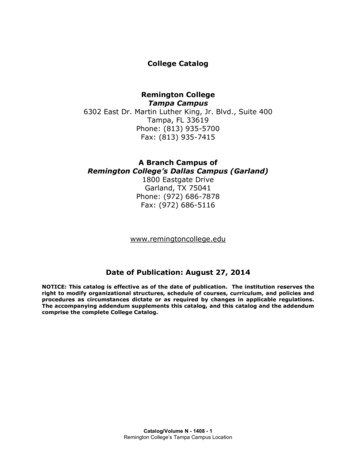
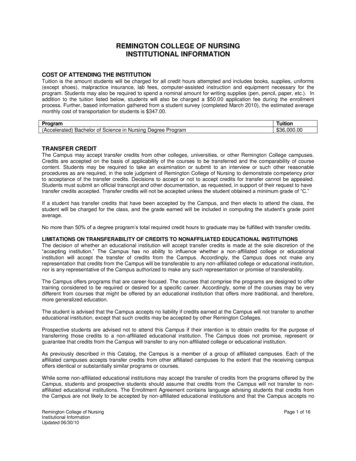
![[ OPTIONAL ] CASE COLLATOR · 90667 LM3231 COMPLETE .](/img/4/91ga8yoa-ts.jpg)
